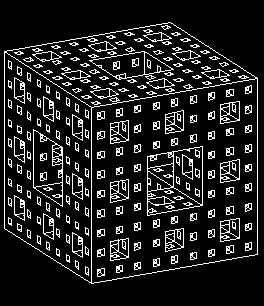

Instead, I would like to try build the sponge with the help of many volunteers building subassemblies that could be brought or shipped to a central location for final assembly. It is not immediately obvious what form the sub-assemblies should take, since they must be joined together after they are built. Building level 1 sponges is easy and takes about an hour to ninety minutes. But you cannot just pretend that they are simple cubes and link their faces to make a level 2 sponge, because each face of a level 1 sponge has 8 cubes which would have to be linked simultaneously with their neighbors. Trying to link level 2 sponges would be even worse.
It must be possible to join the sub-assemblies together by building linking cubes between them. After several false starts, I have devised such a decomposition of the sponge based on a sub-unit that I call a "tripod".

A tripod is a block of four linked cubes, where a corner cube has three cubes attached to three adjacent faces. A sponge of any level can be broken into pieces that are combinations of one, two, three, four, six or eight tripods joined together by additional cubes.

A level 1 sponge can be made by linking 4 tripods together with 4 additional cubes.

A level 2 sponge can be made by linking 32 tripod modules: 4 single tripods, 12 double tripods, 12 triple tripods and 4 quadruple tripods, with 80 additional cubes.

A level 3 sponge can be made by linking 448 tripod modules: 4 single tripods, 84 double tripods, 156 triple tripods, 84 quadruple tripods, 48 double double tripods and 72 double triple tripods, with 1600 additional cubes.
This tripod decomposition has many desirable features. The modules are small and can be completed quickly, making each volunteer's contribution relatively small. (Enthusiastic volunteers can build more modules, if they like.) The modules are regular and easy to teach, understand and build correctly. They can be panelled after construction. Linking modules together is easy and does not require reaching into small, confined spaces. After assembly, the faces of the linking cubes are easily accessible for panelling. The tripods comprise a very large percentage (80 percent) of the final sponge.
I am working on more complete instructions and diagrams of the assembly procedure.